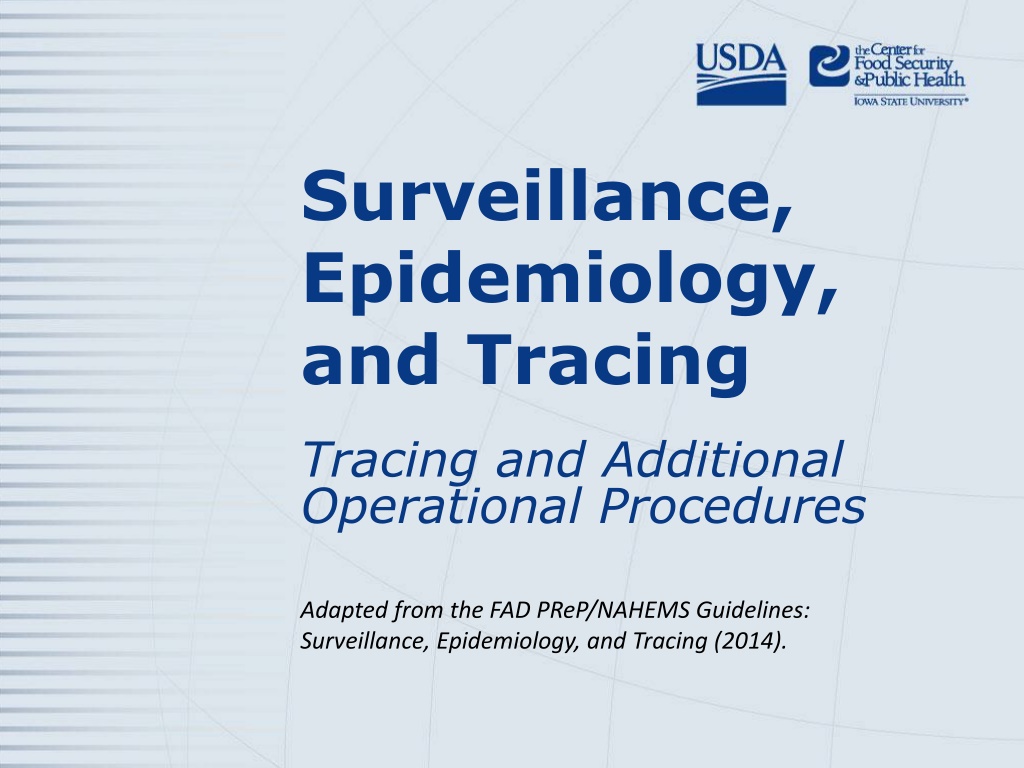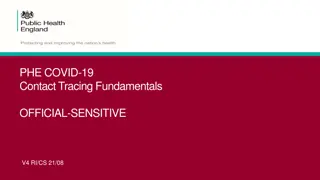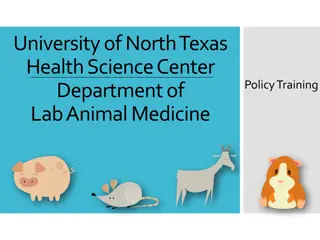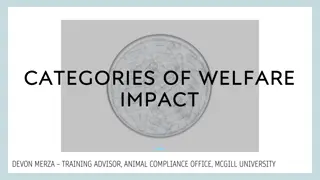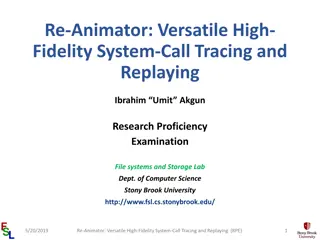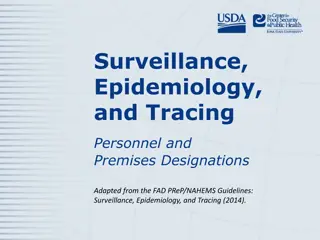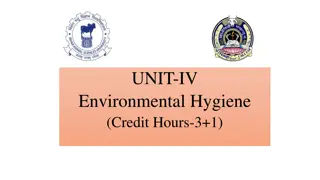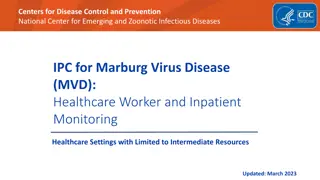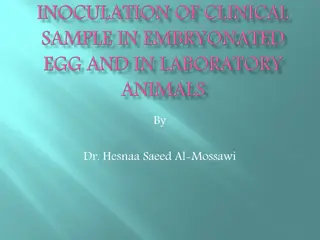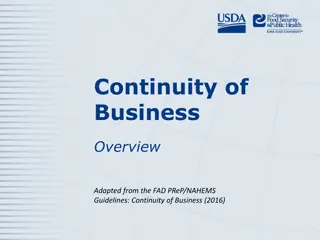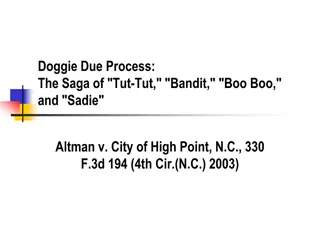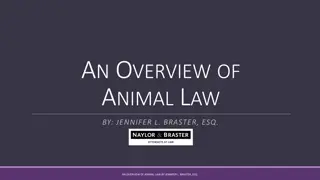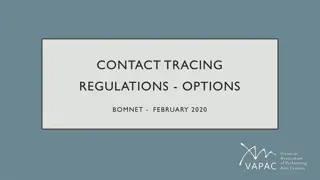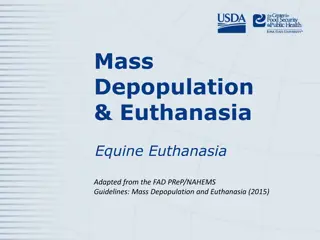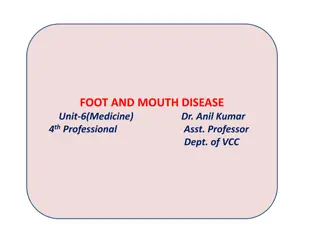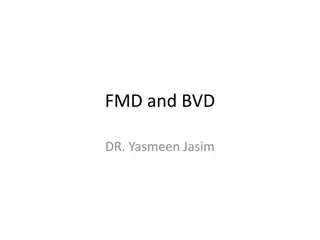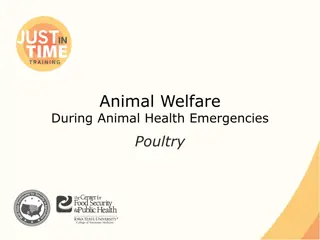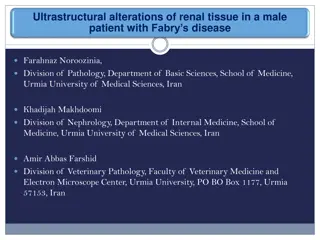Tracing in Animal Disease Control: Guidelines and Procedures
This presentation delves into the importance of tracing in animal disease control, covering trace-back and trace-forward methods, sources of information, collaboration services, and the role of livestock owners. It highlights the guidelines and operational procedures adapted from FAD PReP/NAHEMS, focusing on surveillance, epidemiology, and tracing measures to identify and track potential disease sources and movements in livestock populations.
- Animal Disease Control
- Tracing Guidelines
- Livestock Movement
- Surveillance Collaboration
- Epidemiology Measures
Download Presentation

Please find below an Image/Link to download the presentation.
The content on the website is provided AS IS for your information and personal use only. It may not be sold, licensed, or shared on other websites without obtaining consent from the author. Download presentation by click this link. If you encounter any issues during the download, it is possible that the publisher has removed the file from their server.
E N D
Presentation Transcript
Surveillance, Epidemiology, and Tracing Tracing and Additional Operational Procedures Adapted from the FAD PReP/NAHEMS Guidelines: Surveillance, Epidemiology, and Tracing (2014).
This Presentation Overview of tracing Identifies tracing sources & services Transportation & import requirements Additional tracing procedures FAD PReP/NAHEMS Guidelines: Surveillance, Epi, and Tracing - Tracing USDA APHIS and CFSPH
Tracing FAD PReP/NAHEMS Guidelines: Surveillance, Epi, and Tracing - Tracing USDA APHIS and CFSPH
Tracing Trace-back Animals, animal products, fomites, people, vehicles, equipment, and possible vectors that have been moved onto an Infected Premises Establish the origin of the agent/hazard FAD PReP/NAHEMS Guidelines: Surveillance, Epi, and Tracing - Tracing USDA APHIS and CFSPH
Tracing (contd) Trace-forward Animals, animal products, fomites, people, vehicles, equipment, and possible vectors that have left the Infected Premises FAD PReP/NAHEMS Guidelines: Surveillance, Epi, and Tracing - Tracing USDA APHIS and CFSPH
Tracing Sources Owners/livestock producers VS Surveillance Collaboration Services Animal Disease Traceability Information System Auction/market records Test charts Livestock transporters' manifests and owner/shipper statements Accredited veterinarians and health certificates Import permit systems Brand inspection records Official identification devices FAD PReP/NAHEMS Guidelines: Surveillance, Epi, and Tracing - Tracing USDA APHIS and CFSPH
Livestock Owners Important source of information on animal movements Type, format and quality of farm records may vary May be subject to confidentiality rules FAD PReP/NAHEMS Guidelines: Surveillance, Epi, and Tracing - Tracing USDA APHIS and CFSPH
Surveillance Collaboration Services Records details of: Persons (owners/agents), animals, lab tests Animal identification tag allocation and use Domains (premises and herds/flocks/tanks) Movements (individuals/groups/restrictions) Treatments and vaccinations for animals Graphical representation on digital maps Multi-species recording on the same database Activity scheduling FAD PReP/NAHEMS Guidelines: Surveillance, Epi, and Tracing - Tracing USDA APHIS and CFSPH
Animal Disease Traceability Animal Disease Traceability Information System (ADTIS) Optional method for administering traceability activities States and Tribes collect farm location and contact information at their discretion FAD PReP/NAHEMS Guidelines: Surveillance, Epi, and Tracing - Tracing USDA APHIS and CFSPH
Livestock Dealers or Auction Markets Auction/market records Records maintained by commission firms, dealers, inspectors and veterinarians Market test charts/records Official charts or forms used to record official testing data for program diseases FAD PReP/NAHEMS Guidelines: Surveillance, Epi, and Tracing - Tracing USDA APHIS and CFSPH
Transporters Manifests A manifest or bill of lading must accompany all livestock shipments Carried by livestock transporter Normally includes: Number and type of livestock Shipment origin and destination FAD PReP/NAHEMS Guidelines: Surveillance, Epi, and Tracing - Tracing USDA APHIS and CFSPH
Health Certificates Written by accredited veterinarians Two types Federal Also known as International Health Certificates (IHC) State Certificates of Veterinary Inspection (CVI) FAD PReP/NAHEMS Guidelines: Surveillance, Epi, and Tracing - Tracing USDA APHIS and CFSPH
Import Permit Systems Live animals imported into the U.S. must have a valid permit VS form 17-129, or APHIS ePermits system FAD PReP/NAHEMS Guidelines: Surveillance, Epi, and Tracing - Tracing USDA APHIS and CFSPH
Brand Inspection Record Some states require visual brand inspection for cattle Ownership and transfer of ownership must be documented Maintained by State s brand inspection authority FAD PReP/NAHEMS Guidelines: Surveillance, Epi, and Tracing - Tracing USDA APHIS and CFSPH
Backtags and Eartags Backtags Temporary form of identification For animals moving through livestock dealer or auction market Eartags State-issued Electronic or visually- inspected FAD PReP/NAHEMS Guidelines: Surveillance, Epi, and Tracing - Tracing USDA APHIS and CFSPH
Tracing Databases Animal movements may be complicated Databases produce schematics Example: Emergency Management Response System (EMRS) 2.0 FAD PReP/NAHEMS Guidelines: Surveillance, Epi, and Tracing - Tracing USDA APHIS and CFSPH
Electronic Data Management EMRS essential for: Routine reporting of investigations Surveillance and control programs State-specific disease outbreaks National animal health emergency responses Utilized by multiple groups within ICS May undergo changes FAD PReP/NAHEMS Guidelines: Surveillance, Epi, and Tracing - Tracing USDA APHIS and CFSPH
Additional Operational Procedures FAD PReP/NAHEMS Guidelines: Surveillance, Epi, and Tracing - Tracing USDA APHIS and CFSPH
Additional Procedures Variety of strategies required to contain, control and/or eradicate an FAD: Biosecurity Health and safety Personal protective equipment Cleaning and disinfection Quarantine and movement control FAD PReP/NAHEMS Guidelines: Surveillance, Epi, and Tracing - Tracing USDA APHIS and CFSPH
Biosecurity Management practices Designed to prevent the introduction and spread of disease agents on an animal production facility Utilized by responders entering or leaving a premises Protocols must be followed at all times FAD PReP/NAHEMS Guidelines: Surveillance, Epi, and Tracing - Tracing USDA APHIS and CFSPH
Health and Safety Health and safety of personnel performing duties must be assured Responders may encounter physical, environmental and or psychological hazards FAD PReP/NAHEMS Guidelines: Surveillance, Epi, and Tracing - Tracing USDA APHIS and CFSPH
PPE Special clothing and equipment that places a barrier between an individual and a hazard Prevents the spread of hazards between animals or locations FAD PReP/NAHEMS Guidelines: Surveillance, Epi, and Tracing - Tracing USDA APHIS and CFSPH
Cleaning and Disinfection Cleaning Removal of organic material Washing Removal of materials that can inhibit the action of disinfection Disinfection Process that destroys most pathogenic and non- pathogenic microorganisms to an acceptable level FAD PReP/NAHEMS Guidelines: Surveillance, Epi, and Tracing - Tracing USDA APHIS and CFSPH
Quarantine and Movement Control Upon detection of an FAD in livestock, quarantine and movement controls will be established Restrictions on entering or leaving a premises, area, or region Control the movement of animals, animal products, and fomites in a Control Area FAD PReP/NAHEMS Guidelines: Surveillance, Epi, and Tracing - Tracing USDA APHIS and CFSPH
For More Information FAD PReP/NAHEMS Guidelines: Surveillance, Epidemiology, and Tracing, and SOP: Surveillance http://www.aphis.usda.gov/fadprep Surveillance, Epidemiology, and Tracing web-based training module http://naherc.sws.iastate.edu/ FAD PReP/NAHEMS Guidelines: Surveillance, Epi, and Tracing - Tracing USDA APHIS and CFSPH
Guidelines Content Authors (CFSPH) Kerry Leedom Larson, DVM, MPH, PhD, DACVPM Glenda Dvorak, DVM, MPH, DACVPM Janice Mogan, DVM Courtney Blake, BA Reviewers (USDA APHIS VS) Dr. R. Alex Thompson Dr. Lowell Anderson Dr. Steve Goff Dr. Fred Bourgeois FAD PReP/NAHEMS Guidelines: Surveillance, Epi, and Tracing - Tracing USDA APHIS and CFSPH
Acknowledgments Development of this presentation was by the Center for Food Security and Public Health at Iowa State University through funding from the USDA APHIS Veterinary Services PPT Authors: Patricia Futoma, Veterinary Student; Kerry Leedom Larson, DVM, MPH, PhD, DACVPM Reviewers: Janice Mogan, DVM; Melissa Lang, BS
